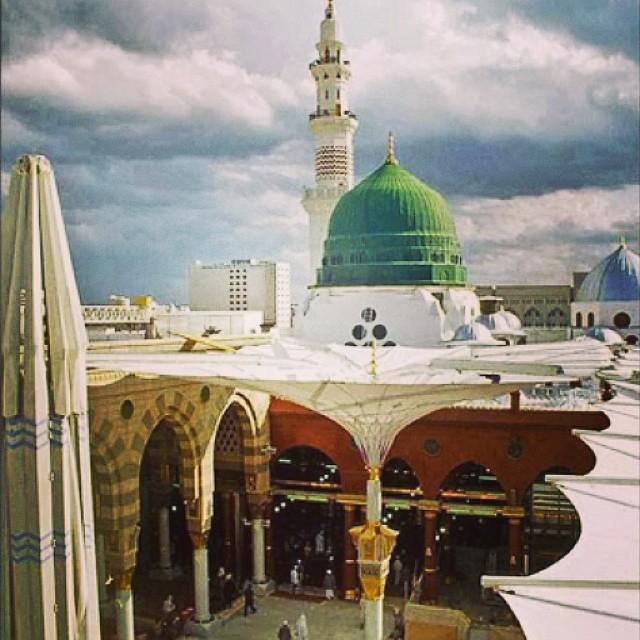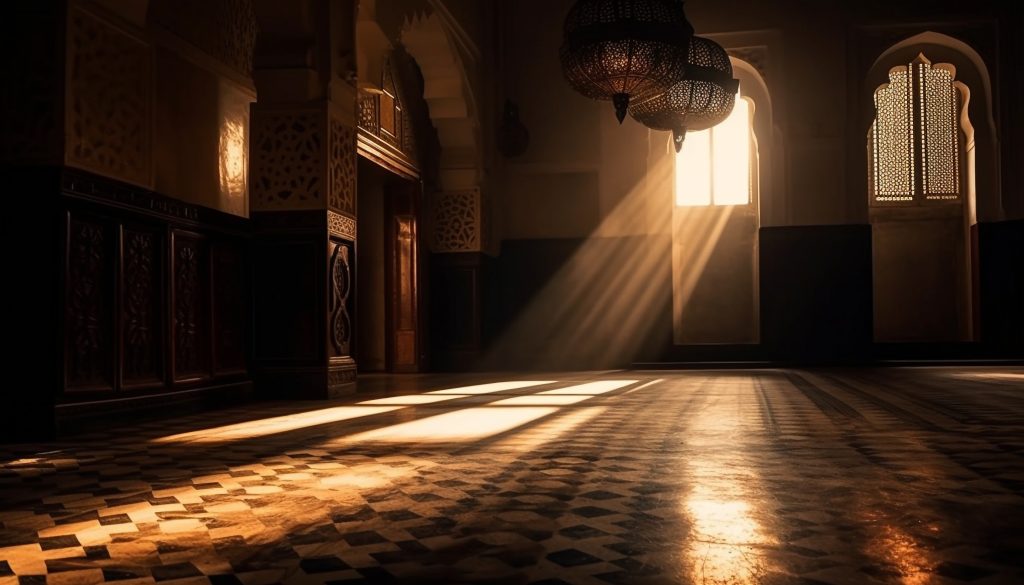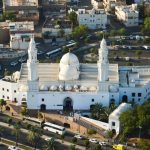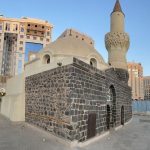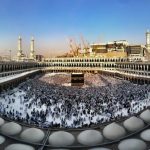The Black Stone: An Esteemed Artifact of Islamic Heritage
The Black Stone (Arabic: ٱلْحَجَرُ ٱلْأَسْوَد, romanized: al-Ḥajar al-Aswad) is an esteemed rock embedded in the eastern corner of the Kaaba, the ancient sanctuary situated at the heart of the Grand Mosque in Mecca, Saudi Arabia. As a focal point of Islamic pilgrimage, the Black Stone holds profound significance for millions of Muslims around the world. It is revered not only as a sacred object but also as a symbol of faith and connection to the divine.
According to Muslim tradition, the Black Stone is believed to date back to the primordial era of Adam and Eve, marking it as an artifact steeped in history and spirituality. Its presence at the Kaaba enhances the site’s importance as a destination for Umrah and Hajj, drawing pilgrims who seek to engage in acts of worship and reflection.
This blog, part of the Umrah International series, aims to explore the multifaceted history and significance of the Black Stone, delving into its origins, the events that have shaped its legacy, and its role in contemporary Islamic practice. Join us as we unravel the rich narrative surrounding this revered stone and its enduring impact on the spiritual lives of Muslims across the globe.
Historical Context and Pre-Islamic Significance
The veneration of the Black Stone predates Islam, having been a focal point of worship during the pre-Islamic era, when the Kaaba served as a sanctuary housing numerous idols revered by various Arabian tribes. Historical accounts reveal that the Kaaba was a site of pilgrimage, frequented by Nabataeans and other tribes who journeyed to pay homage to their deities. The Black Stone, in this context, was emblematic of spiritual significance, reflecting a deep-rooted tradition of reverence for unusual stones in ancient Semitic cultures.
The Role of the Black Stone in Islamic Tradition
According to Islamic tradition, the Prophet Muhammad reinstated the Black Stone in its current position within the Kaaba’s wall in 605 CE, shortly before receiving his first revelation. This act was pivotal in establishing the Black Stone’s status within Islamic practice. Over the centuries, the stone has endured fragmentation, now comprised of several pieces that are encased within a silver frame. Its physical appearance—a polished, dark rock—has led to its description as akin to a meteorite, further enhancing its mystique.
Physical Description
The Black Stone is currently made up of several fragments, which have been expertly joined together. These fragments are encased in a silver frame affixed to the Kaaba’s exterior wall. The visible face of the stone measures approximately 20 cm by 16 cm, though its original dimensions remain unclear, having fluctuated throughout history due to various reconstructions and rearrangements.
Positioned at the eastern corner of the Kaaba, known as al-Rukn al-Aswad, the location of the Black Stone holds ritual significance. It faces the east wind, which is historically associated with rain and fertility, suggesting a deep symbolic connection to life-giving forces.
The Ritual of Tawaf
During the annual pilgrimage of Hajj, millions of Muslim pilgrims engage in the tawaf, a ritual involving circumambulating the Kaaba seven times in a counterclockwise direction. A key aspect of this ritual is the istilam, wherein pilgrims attempt to kiss the Black Stone, an act emulating the Prophet Muhammad’s reverence. Due to the overwhelming crowds, direct contact with the Stone can be challenging; hence, many pilgrims now simply gesture towards it as they circle the Kaaba.
This ritual not only symbolizes devotion but also serves as a reminder of the unity of the Muslim Ummah (community) in their shared faith and worship. Each circuit around the Kaaba reinforces the spiritual connection between the pilgrim and the divine, with the Black Stone acting as a focal point for prayer and reflection.
Symbolism and Theological Interpretations
The Black Stone is imbued with rich symbolism within Islamic thought. It is often believed that the stone was originally a dazzling white, transformed to its current dark hue due to the accumulated sins of those who have touched it. This narrative serves to underscore the notion of human fallibility and the importance of repentance.
Several traditions assert that the Black Stone is a witness to the fidelity of pilgrims, symbolizing a covenant between humanity and the divine. Some interpretations suggest that it was originally a celestial object, bestowed with the power of speech and placed on Earth to serve as a link between heaven and humanity.
Historical Challenges and Desecration
Throughout its long history, the Black Stone has faced various challenges and instances of desecration. Notably, during the Umayyad Caliphate’s siege of Mecca in 683 CE, the Stone was severely damaged. In the following centuries, it was stolen by the Qarmatians in 930 CE, who transported it to their stronghold. After a protracted period of negotiation, it was returned, albeit in a fragmented state. Such events highlight the turbulent history surrounding this sacred relic.
Additionally, attempts to defile the Stone, such as the reported incident in 1674 where it was smeared with excrement, underscore the passionate sentiments surrounding the Black Stone and the lengths to which individuals have gone to protect it from indignity.
Scientific Inquiry into the Black Stone
The nature of the Black Stone has long intrigued scientists and scholars alike. Various hypotheses have emerged regarding its composition, with descriptions ranging from basalt and agate to meteoritic material. Notably, Paul Partsch’s 1857 analysis proposed a meteoritic origin, while others, including geologists from the British Natural History Museum, have expressed skepticism about its classification as a meteorite.
Recent theories suggest that the Black Stone may be a form of impactite, linked to a meteorite event in the Wabar region. However, definitive scientific analyses have yet to be conducted on the Black Stone, leaving its origins shrouded in mystery.
The Modern Pilgrim Experience
In contemporary times, the experience of visiting the Black Stone has evolved, influenced by the exponential increase in the number of pilgrims during Hajj. The challenges of crowd management have led to innovative solutions to ensure that pilgrims can engage with this sacred relic while maintaining safety and respect.
Personal narratives from pilgrims reveal profound emotional connections to the Black Stone. Many describe moments of spiritual awakening and deep reflection as they approach the Kaaba and the Stone. Such accounts serve as a testament to the enduring power of this sacred relic, linking past traditions with present experiences.
The Virtues of the Hajar al-Aswad
Numerous Hadiths highlight the esteemed virtues of the Hajar al-Aswad:
Abdullah ibn Umar reported that the Prophet Muhammad (peace be upon him) stated:
“Touching the Black Stone and the Yemeni Corner indeed expiates sins.”
(Narrated in Musnad Ahmad)
Abu Hurayrah recounted that the Messenger of Allah (peace be upon him) said:
“The Black Stone descended from Paradise, and it was whiter than milk. However, the transgressions of the children of Adam darkened it.”
(Narrated in Jami’ al-Tirmidhi)
Ibn Hisham mentioned:
When I asked Ata’ about the Black Stone, he replied, “Abu Hurayrah informed me that he heard the Messenger of Allah (peace be upon him) say, ‘Whoever interacts with it has interacted with al-Rahman (the All-Merciful).’”
(Narrated in Sunan Ibn Majah)
Abu Hurayrah further conveyed that the Messenger of Allah (peace be upon him) said regarding the Black Stone:
“I swear by Allah, it will be resurrected on the Day of Judgment with two eyes that see and a tongue that speaks. It will testify for anyone who performed Istilam of it.”
(Narrated in Jami’ al-Tirmidhi, Sunan Ibn Majah, and Sunan al-Darimi)
Zubayr ibn Adiyy reported:
A man asked Ibn Umar about performing Istilam of the Hajar al-Aswad. He replied, “I witnessed the Messenger of Allah (peace be upon him) touching and kissing it.”
(Narrated in Sahih al-Bukhari)
The History of the Hajar al-Aswad
Before the Prophet Muhammad (peace be upon him)
According to Islamic tradition, the Black Stone was brought from Heaven by the angel Gabriel during the time of Adam. Scholar Ibn Sa’d recounts that when Adam performed Hajj, he placed the Hajar al-Aswad on Mount Abu Qubais.
The Stone was preserved on the mountain during the Great Flood in the era of Noah. Later, it was positioned in its rightful place in the Kaaba by Abraham and his son, Ishmael.
Historian al-Ya’qubi states that Allah commanded Abraham to construct the Kaaba, a task he undertook alongside Ishmael. When they reached the spot for the Hajar al-Aswad, it was retrieved from Mount Abu Qubais and placed in its designated position.
During the Lifetime of the Prophet (peace be upon him)
A pivotal event concerning the Hajar al-Aswad unfolded during the lifetime of the Prophet Muhammad (peace be upon him). Following a flash flood that severely damaged the Kaaba, the tribe of Quraish, tasked with its custodianship, resolved to undertake its reconstruction.
The four tribes of Quraish agreed to share the expenses, yet a dispute erupted over who would have the honor of placing the Black Stone in the Kaaba. An elder proposed that the next person to enter the sanctuary would decide. That individual was the Prophet Muhammad (peace be upon him). Demonstrating remarkable wisdom, he suggested that the Black Stone be placed on a large cloak, allowing representatives from each tribe to lift it into position.
Once the cloak was raised near its designated spot, the Prophet (peace be upon him) took it upon himself to place the Hajar al-Aswad within the sacred structure.
Abdullah ibn Zubayr
During Abdullah ibn al-Zubayr’s reign, the Kaaba underwent reconstruction in 65 AH (685 CE) due to damage from a fire during Yazid ibn Mu’awiya’s siege of Makkah. This conflict arose when Abdullah refused allegiance to Yazid, igniting a revolt in Madinah. Yazid dispatched an army to Madinah and subsequently to Makkah, leading to the siege.
Al-Husayn ibn Numayr, Yazid’s successor, continued the siege, resulting in extensive damage to the Kaaba from projectiles and fire. Afterward, Abdullah ordered the demolition of the remains of the Kaaba, during which the Black Stone fractured into three pieces. He bound these fragments with silver and kept them in his home until the Kaaba was rebuilt. Abdullah ibn al-Zubayr is recognized as the first to encase the Hajar al-Aswad in silver.
Despite the absence of the Hajar al-Aswad during reconstruction, Tawaf continued around a temporary wooden structure. Once the walls reached the previous height of the Black Stone, it was promptly reinstalled, securely affixed with two stones.
The Qarmatians
The Hajar al-Aswad has faced numerous incidents of theft throughout history, most notably by the Qarmatians, a radical Shia Ismaili sect from Bahrain. This event saw the Black Stone seized and concealed for 22 years.
On the Day of Tarwiyah in 317 AH (930 CE), Abu Tahir al-Jannabi, leader of the Qarmatians, attacked Makkah. Exploiting the vulnerability of pilgrims, they raided the Kaaba, uprooted the Black Stone, and transported it to Bahrain, resulting in approximately 30,000 deaths during their violent campaign.
This assault shocked the Muslim world and underscored the vulnerabilities of the Abbasid government. Both the Abbasids and Fatimid Caliph Abdallah al-Mahdi condemned Abu Tahir’s actions and demanded the Black Stone’s return, but he ignored these appeals, seeking to expand his influence.
In 318 AH (931 CE), the Qarmatians established a competing pilgrimage site in al-Jeshah, attempting to compel residents of Qatif to perform Hajj there, which led to further bloodshed.
Years later, negotiations with the Abbasid government resulted in a peace treaty in 327 AH (939 CE). Ultimately, the Black Stone was returned to Makkah in 339 AH (951 CE).
Ibn Kathir describes this moment:
“In the blessed year of 339, during Dhul-Qa’dah, the Makkan Black Stone was restored to its position within the House by the Qarmatians. Prince Bajkam al-Turki offered 50,000 dinars for its return, but this was declined. Eventually, the Stone returned without conditions, bringing immense joy to Muslims after its 22-year absence.”
Other Incidents
In ‘Ithaf Al-Wari Bi Akhbar Umm Al-Qura,’ Ibn Fahd Al-Makki recounts an event from 363 AH (973 CE) involving a Christian man hired to desecrate the Kaaba. Upon striking the Black Stone, he was killed by a Yemeni man performing Tawaf.
In the 5th century AH (11th century CE), another attack was orchestrated by ten horsemen sent by the Fatimid caliph al-Hakim bi-Amr Allah. After a Friday prayer, a man struck the Black Stone three times with an axe, declaring his intent to demolish the Kaaba. He was swiftly killed by bystanders. The Hajar al-Aswad remained damaged for two days, with visible scratches and cracks.
Imam Ibn Allan recounts an incident from 990 AH (1582 CE) when a man from Iraq struck the Black Stone with an axe, only to be killed by Prince Nasser Jawish, who was present at the Kaaba.
Sheikh Hussein Ba Salamah notes a 1932 CE incident when an Afghan man dislodged a piece of the Black Stone and stole from the Kaaba. He was apprehended and executed.
Fragments in Turkey
Additionally, seven fragments of the Black Stone can be found in Istanbul and Edirne, Turkey. In Istanbul, four pieces are displayed in the Sokollu Mehmet Pasha Mosque, another in the mihrab of the Blue Mosque, and one above the entrance of Suleiman the Magnificent’s tomb. These fragments were removed during renovations in the Ottoman era and are now housed in the Sokullu Mehmet Pasha Mosque.
In Edirne, a fragment is believed to be present in the Old Mosque, displaying distinct differences from those in Istanbul and the Kaaba. The Imam suggests this stone may not be from the Hajar al-Aswad but rather from Hajar as-Sa’adah at the Yemeni Corner.
Tawaf
The Hajar al-Aswad is central to the rite of Tawaf. According to the Hanafi school, it is sunnah to commence Tawaf from the Hajar al-Aswad, while the Shafi’i, Maliki, and Hanbali schools consider it wajib. Hanafis argue there is no specific directive in the Quran regarding the starting point, while the other schools rely on the Prophet’s example.
Istilam
Istilam refers to the act of kissing, touching, or gesturing towards the Hajar al-Aswad at the beginning and end of each Tawaf circuit. It is sunnah for pilgrims to perform this act, though large crowds often necessitate gesturing instead.
When approaching the Hajar al-Aswad, one should:
- Kiss: If reachable, place hands on the stone, say “Bismi Llāhi wa Llāhu akbar,” and kiss it lightly, preferably three times if possible.
- Touch: If unable to kiss it, touch it and then kiss your hands.
- Salute: If reaching it isn’t possible, face the stone, raise your hands to your earlobes, and say “Bismi Llāhi wa Llāhu akbar,” kissing your palms if desired.
When attempting to kiss the Hajar al-Aswad, one must be considerate of others. Although kissing the Stone is a sunnah, causing harm is forbidden. In crowded situations, it is recommended to simply touch or gesture towards it instead.
The following supplication may be recited while approaching the Hajar al-Aswad during each circuit:
بِسْمِ اللّٰهِ وَاللّٰهُ أَكْبَرُ ❁ اَللَّهُمَّ إِيمَاناً بِكَ وَتَصْدِيقاً بِكِتَابِكَ ❁ وَوَفَاءً بِعَهْدِكَ ❁ وَاتِّبَاعاً لِسُنَّةِ نَبِيِّكَ مُحَمَّدْ ❁
Bismi Llāhi wa Llāhu akbar. Allāhumma īmānan bika wa taṣdīqan bi kitābika wa wafāʿan bi ʿahdika wattibāʿan li sunnati nabiyyika Muḥammad ﷺ.
“In the name of Allah, Allah is the Greatest. O Allah, out of faith in You, conviction in Your book, in fulfilment of Your covenant, and in emulation of Your Prophet’s sunnah ﷺ.”
Across various cultures, including Arab traditions, there exists a custom of kissing the hands of parents, elders, and scholars as a mark of respect. This practice mirrors the tradition of our Prophet (peace be upon him) and symbolizes reverence towards Allah. Thus, when Muslims enter Masjid al-Haram, they commence with Tawaf and kiss the Black Stone as a greeting to Allah.
The Prophet’s ﷺ Istilam
During Tawaf, the Prophet Muhammad (peace be upon him) would touch and kiss the Hajar al-Aswad and the Rukn al-Yamani. Abdullah ibn Umar noted:
“The Apostle of Allah ﷺ consistently touched both the Rukn al-Yamani and Hajar al-Aswad in each circumambulation.”
(Narrated in Sunan Abu Dawud)
He would recite “Bismillahi Wallahu Akbar” when reaching the Rukn, and “Allahu Akbar” at the Hajar. Abdullah ibn Umar remarked that after performing Istilam, the Prophet ﷺ would kiss his hand. Nafi’ reported:
“I observed Ibn Umar touching the Stone and then kissing his hand. He stated, ‘I have continued this practice since witnessing the Messenger of Allah ﷺ do it.’”
(Narrated in Sahih Muslim)
The Prophet ﷺ advised Umar ibn al-Khattab on proper conduct in crowded situations near the Hajar al-Aswad, urging him to avoid pushing or harming others. If unable to reach it, he instructed Umar to face the Stone and recite “La ilaha illa Allah” and “Allahu Akbar.”
(Narrated in Musnad Ahmad)
Additionally, the Prophet ﷺ performed Tawaf mounted on a camel, pointing towards the Hajar al-Aswad with a stick and proclaiming Takbir. Abdullah ibn Abbas reported:
“Allah’s Messenger ﷺ performed Tawaf around the Kaaba on his camel, pointing at the corner with something in his hand, saying, ‘Allahu Akbar.’”
(Narrated in Sahih al-Bukhari)
The Prophet ﷺ did not touch the other two corners of the Kaaba. Umar ibn al-Khattab remarked:
“By Allah! I know you are a stone, incapable of benefit or harm. Had I not witnessed the Prophet ﷺ touching and kissing you, I would never have done so.”
(Narrated in Sahih al-Bukhari)
The Theft of the Hajar al-Aswad: A Historical Overview
Around 930 CE, a momentous and troubling event unfolded in Islamic history when the Hajar al-Aswad, or Black Stone, was stolen from the Ka’bah by the Qarmatians, a radical sect of Ismaeli Shia. This group, known for its extreme views and militant actions, orchestrated a devastating raid on the holy city of Makkah.
During this tumultuous attack, the Qarmatians not only looted the Ka’bah but also engaged in acts of profound desecration. One of the most shocking actions taken by the raiders was the contamination of the Well of Zamzam, a revered water source for Muslims, by throwing Muslim corpses into it. This act of violence highlighted the depth of the Qarmatians’ contempt for Islamic traditions and the sanctity of sacred spaces.
Following their assault, the Qarmatians successfully transported the Hajar al-Aswad back to their base in Ihsaa, located in present-day Bahrain. The theft of the Black Stone, an object of immense spiritual significance, sent shockwaves through the Muslim community, inciting outrage and sorrow.
Historian Al-Juwayni documented that the stone remained in the possession of the Qarmatians for nearly two decades. The Black Stone’s return to Makkah occurred around 952 CE, when it was finally restored to its rightful place within the Ka’bah. This event was not only a relief for the Muslim community but also served as a poignant reminder of the resilience of Islamic heritage in the face of adversity.
The theft and eventual restoration of the Hajar al-Aswad illustrate the complexities of historical interactions between various sects and the enduring significance of sacred sites within Islam. The incident remains a significant chapter in the broader narrative of Islamic history, reflecting both the vulnerabilities of sacred spaces and the unwavering devotion of the Muslim community to reclaim and honor their heritage.
Conclusion: A Timeless Symbol of Faith
The Black Stone remains an enduring symbol of faith and devotion in the Islamic tradition. Its historical, spiritual, and cultural significance transcends time, continuing to inspire millions around the world. As pilgrims flock to Mecca, the Black Stone stands as a testament to the resilience of faith and the shared spiritual journey of humanity.
For those looking to embark on this profound pilgrimage, Umrah International Services is dedicated to facilitating a fulfilling and enriching experience. Our comprehensive packages ensure that each pilgrim can connect deeply with their faith while navigating the spiritual and logistical aspects of their journey. Join us in honoring this timeless symbol as we support your path to Mecca and the sacred Black Stone.


